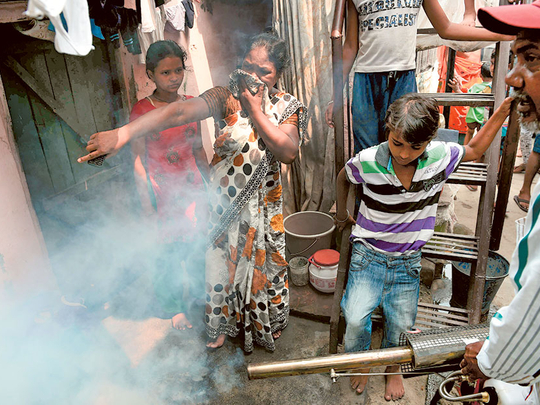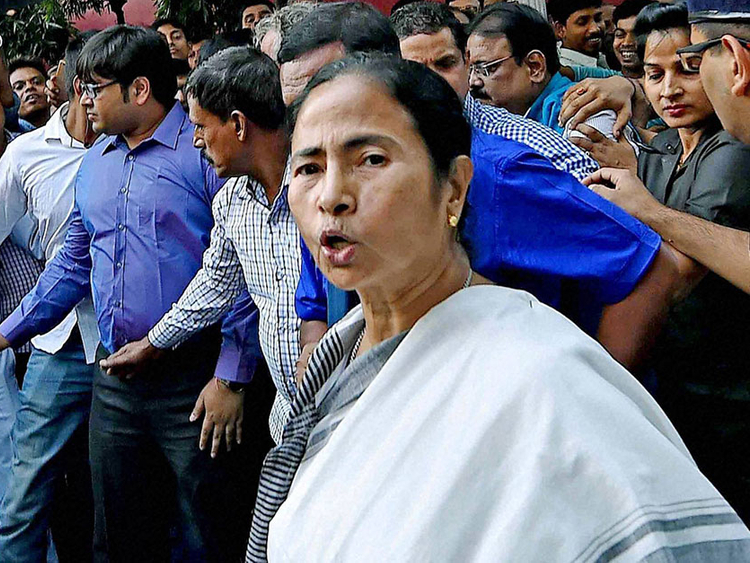
Deaths due to dengue in the Indian state of West Bengal have caused people to express concern.
But medical professionals have been accused of spreading "rumours" — causing undue alarm among the people over the incidents of dengue, chikungunya, malaria and Scub Taefus diseases in the state.
Chief Minister Mamata Banerjee had recently accused private diagnostic laboratories and hospitals of unnecessarily spreading panic.
Woman forced to sit in the rain with son’s body
In annual ritual, Delhi struggles with dengue, chikungunya
Time to take ‘Swachh Bharat’ drive seriously
Fear of dengue grips Mumbai
Dengue death toll rises to 301 in Sri Lanka
Philippines fights dengue with text messages
She was quoted as saying that 40 persons had died of vector-borne diseases in her state, out of which 13 had died of dengue.
On Friday, Governor Keshari Nath Tripathi wrote a letter to the Banerjee-led Trinamool Congress government stating that due to the "serious nature of all these diseases and the concern expressed by a large number of the population in this regard", the government must ensure that those affected should receive timely treatment.
Prevention, treatment
The letter states that "all efforts should be made for treatment as well as prevention of these diseases”.
The Raj Bhavan, the official residence of the Governor of West Bengal (located in the state' capital city Kolkata) expressed concerns about people's health over "incidents of dengue, chikungunya, malaria and Scub Taefus diseases in the state", citing the local media reports and "other sources".
On Friday, the Indian Express reported one more death allegedly due to dengue at Beliaghata ID hospital in Kolkata.
A 38-year-old Bangladeshi woman, Lakhi Ghosh, died, but doctors avoided writing dengue on her death certificate and mentioned viral fever as the cause, the paper said. The daily that said Ghosh had been diagnosed with dengue, was admitted to the hospital on Friday suffering from high fever for the last five days, the paper reported.
In 2015, India’s capital, New Delhi, grappled with what doctors described was the worst outbreak of dengue fever that the city has seen in years — with at least 1,900 cases and at least 11 deaths.
Apart from Delhi, the dengue scare also spread in Punjab and Haryana, with more than 1,400 cases altogether of the vector-borne disease being reported from the two states in 2015.
As part of a concerted anti-dengue action, the government has ordered 1,000 additional beds in overcrowded hospitals and cancelled the leaves of doctors, nurses and paramedics.
Cleanliness drive
On October 2, 2014, Prime Minister Narendra Modi launched a nationalwide cleanliness programme known as Swachh Bharat Abhiyan (SBA, or "clean India mission"), on the birth anniversary of Mahatma Gandhi.
One of the Modi's pet projects, SBA aims to clean up the streets, roads and infrastructure of India's cities, smaller towns, and rural areas — in the hope of stamping out several diseases by improving sanitation.
A key target of the campaign is mosquitoes breeding in stagnant and fresh waters — the primary reason for the thriving of the dengue-transmitting Aedes Aegypti mosquitoes.
Over the years, India has been a witness to the outbreak of several diseases, including dengue.
The death of renowned Bollywood filmmaker Yash Chopra in October 2012 due to dengue has triggered fears that dengue could affect anyone — rich or poor.
Though local authorities had been spearheading drives to control the spread of this disease through fumigation, especially in the slum areas, but the erratic rains and the heat that followed have been blamed for the spike in dengue cases.
After the monsoon, stagnant water, puddles, open water tanks and even flower vases — become breeding ground for mosquitoes.
Studies also show that temperatures play a part.
For example, one study found that the state of Kerala, being warm and wet (temperature range 23.5-30 degrees Celsius) — experiences the highest number of dengue cases; while in states with lower temperatures (17-18 degrees Celsius), a longer incubation period leads to decreased virus transmission.
The incubation period is the shortest during the monsoon season in most states, which raises the risk of dengue during the season, the researchers found.
Mosquito life cycles
The life cycle of all mosquitoes is comprised of the egg, larval, pupal and adult stages.
Male mosquitoes feed on plant nectar alone, while females extract the blood of hosts in order to develop and nourish eggs.
Most mosquitoes lay their eggs directly into water. Others lay their eggs near bodies of water but not within them.
The length of the mosquito life cycle varies between species and is dependent upon environmental conditions such as temperature and moisture.
(1) Eggs will hatch into larvae within 24 to 48 hours.
(2) Larvae soon grow to become approximately 5 mm in length. Most larvae breathe through air tubes.
(3) Larger larvae can be seen floating just above the surface of infested waters. Larvae and pupae usually cannot survive without water. If a water source evaporates before the larvae and pupae within it transform into adult mosquitoes, those young often will die.
(4) Within seven to 10 days, larvae enter the pupal stage. Pupae are also visible upon the surface of the breeding site.
(5) After a mosquito is fully developed, it will emerge as an adult from its pupal case. At this time, the new adult stands upon the water and dries its wings to prepare for flight.
(6) Adult female mosquitoes will then seek an animal on which to feed.
(7) Females are capable of flying for miles if necessary and can lay over 100 eggs at a time.













